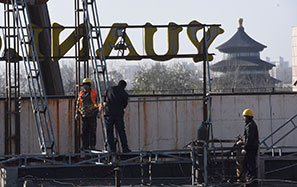New yuan rate is said to 'fix distortions'
Too early to judge full implications of RMB devaluation
The People's Bank of China's move to devalue the country's currency rattled global equity markets and pressured commodity prices on Tuesday.
China's central bank Tuesday lowered the rate at which the yuan is permitted to trade against the US dollar by 1.9 percent. The PBOC also said it will base the daily rate more on market conditions.
The PBOC cut the reference rate against the US dollar to 6.2298 yuan per dollar, down from 6.1162 yuan a day earlier, the lowest level in more than two years.
The move would correct price distortions from the bank's previous interventions, experts said.
However, the bank stressed that Tuesday's depreciation was a "one-off" move to fix the discrepancy between the reference rate and the market's spot rate. The spot rate has been consistently higher by about 1.5 percent since June.
The currency can fluctuate by as much as 2 percent a day.
"While it is too early to judge the full implications of the change in the PBOC reference rate, China has indicated that the changes announced today are another step in its move to a more market-determined exchange rate," the US Treasury Department said in a statement on Tuesday.
World stock markets tumbled on Tuesday, with US stock indices falling 1 percent or more. Companies like US construction-equipment maker Caterpillar Inc that sell to China were hit hard.
The devaluation placed more pressure on commodity markets, pushing copper futures to a six-year low at one point and driving down already weak crude oil prices.
In China, shares of exporters rose while shares of importers and airlines fell.
The yuan move is expected to make Chinese exports more competitive while the price of imported goods will probably rise.
Ma Jun, chief economist at the central bank's research bureau, said that the central parity adjustment "does not mean a depreciating trend for the yuan".
"The economic fundamentals can support a stable yuan exchange rate, since China's 7 percent GDP growth is higher than most countries' and is especially higher than the other emerging economies with greater exchange rate fluctuations," Ma said.
A persistent export surplus, large foreign exchange reserves, low inflation, a moderate fiscal deficit and government debt will ensure a stable currency, he added.
Market-based reforms like this may aid China's campaign to have the yuan included in the International Monetary Fund's Special Drawing Rights basket of currencies which the organization uses to value reserve assets.
The basket includes the dollar, euro, British pound and Japanese yen.
Zhu Haibin, chief China economist with JP Morgan Chase & Co, said the policy is conducive to the yuan's inclusion in the International Monetary Fund's Special Drawing Rights, as its review last week suggested that the central parity rate should be responsive to changes in market conditions.
David Dollar, a senior fellow at the Brookings Institution's John L Thornton China Center in Washington, said: "I think the 1.9 percent is too small to make much difference. I think that's why the key issue is where it goes from here."
"If it turns into a significant devaluation trend - significant would be 10 percent or more - that would have a significant effect on trade, but it would also generate a lot of tension between China and the United States," Dollar said.
"A falling yuan and a rising bilateral US trade deficit with China will sharpen congressional criticism of China's currency policies," wrote Eswar Prasad, Tolani Senior Professor of Trade Policy at Cornell University.
"But the administration has little economic basis for criticizing China's move towards greater exchange-rate flexibility.
"Indeed, preventing the yuan from depreciating further would run counter to US and IMF calls for a more market-determined exchange rate," Prasad said.
"China's economic growth was falling, possibly to below 7 percent," said Sung Won Sohn, a professor of economics at California State University Channel Islands in Camarillo.
"Exports fell 8.3 percent in July compared to a year ago. In order to keep the unemployment rate stable. (China) needs at least 7 percent economic growth."
Sohn noted that the move won't solve all of China's problems, including excess capacity, especially in basic industries like steel, aluminum, etc, real-estate bubble, problem loans at Chinese banks and the gyration in the stock market.


















